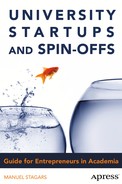Book Description
University Startups and Spin-Offs teaches university students, researchers, and educators the most effective strategies and tactics for launching their own startups from academic platforms with the backing of school programs, public grants, incubators, seed accelerators, and private partnerships in all parts of the world.
Serial entrepreneur Manuel Stagars advises students, faculty, and researchers how to test their ideas for marketability, how to develop commercial products out of research projects, and how to engage companies and investors with attractive value propositions. The author has seventeen years of experience as startup entrepreneur, founder of seven companies in the United States, Europe, and Japan, consultant to universities on commercializing their research programs, angel investor, and startup mentor. Stagars’ advice is field-tested, battle-hardened, and supported with a wealth of instructive first-hand examples from his international experience.
The author advises academic entrepreneurs to take matters into their own hands instead of relying on the initiative and support of universities and governments. He shows students and researchers how to fit lean startup methods to their existing university ecosystems, leveraging their strengths without getting bogged down in bureaucratic morass. Avoiding theory and jargon, the book focuses on real-world situations, practical steps, checklists, and case studies. University students and researchers will learn the skills they need to become startup entrepreneurs on an academic platform.
The final part of University Startups and Spin-Offs addresses university administrators, educators, technology licensing officers, incubator managers, and government grant officers. It shows them with practical examples from the private and academic sectors how to integrate startups into the fabric of the university, develop a thriving entrepreneurial ecosystem for students and researchers, leverage latent network effects, build bridges between scientific research and industries seeking innovative solutions, enhance the public image of the university, and motivate the university’s best and brightest to engage in startup enterprises that will deliver benefits to the university and the public as well as to themselves.
Table of Contents
- Cover
- Title
- Copyright
- Apress Business
- Dedication
- Contents
- About the Author
- Acknowledgments
- Preface
- Introduction
- Chapter 1: The Status Quo: How Do Startups Fit into Universities?
- Chapter 2: The Lean Startup Changed Everything
- Chapter 3: What Does It Mean to Be a Startup Entrepreneur?
- Chapter 4: Engaging Others with Actionable Next Steps
- Chapter 5: Benefits vs. Features
- Chapter 6: Simple Strategies to Get Unstuck
- Chapter 7: Troubleshooting
- Chapter 8: The Financial Model
- Chapter 9: The Legal Setup of Your Startup
- Chapter 10: Communication Skills and Meetings
- Chapter 11: Startup Grants:Can Government Programs Stimulate Entrepreneurship?
- Chapter 12: Venture Capital and Angel Investors
- Chapter 13: Incubators and Accelerators
- Chapter 14: Moving Past the Startup Stage
- Chapter 15: How Do Universities Measure the Impact of Their Research?
- Chapter 16: Why Are University Startups Not Taking Off?
- Chapter 17: How Universities Can Support Their Startups Today
- Chapter 18: Building a Bridge to the Market
- Chapter 19: Platform Thinking for Startup Success
- Chapter 20: More Platform Projects
- Index
- Other Apress Business Titles You Will Find Useful
